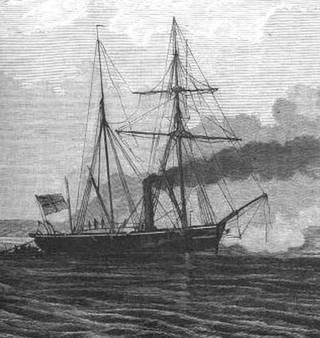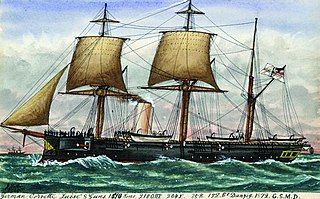
SMS Seeadler was an unprotected cruiser of the Bussard class, the third member of a class of six ships built by the German Kaiserliche Marine. Her sister ships included Bussard, the lead ship, along with Falke, Condor, Cormoran, and Geier. Seeadler was built at the Kaiserliche Werft in Danzig in late 1890, launched in February 1892, and commissioned in August of that year. Intended for colonial service, Seeadler was armed with a main battery of eight 10.5-centimeter (4.1 in) guns and had a top speed of 15.5 knots.

SMS Gneisenau was a Bismarck-class corvette built for the German Imperial Navy in the late 1870s. The ship was named after the Prussian Field Marshal August von Gneisenau. She was the fifth member of the class, which included five other vessels. The Bismarck-class corvettes were ordered as part of a major naval construction program in the early 1870s, and she was designed to serve as a fleet scout and on extended tours in Germany's colonial empire. Gneisenau was laid down in June 1877, launched in September 1879, and was commissioned into the fleet in October 1880. She was armed with a battery of fourteen 15 cm (5.9 in) guns and had a full ship rig to supplement her steam engine on long cruises abroad.

SMS Bremen was the lead ship of the seven-vessel Bremen class of light cruisers, built for the German Kaiserliche Marine in the early 1900s. She and her sister ships were ordered under the 1898 Naval Law that required new cruisers be built to replace obsolete vessels in the fleet. The design for the Bremen class was derived from the preceding Gazelle class, utilizing a larger hull that allowed for additional boilers that increased speed. Bremen was armed with a main battery of ten 10.5 cm (4.1 in) guns and had a top speed of 22 knots.

SMS Vineta was a protected cruiser of the Victoria Louise class, built for the German Imperial Navy in the 1890s. Vineta was laid down at the AG Vulcan shipyard in 1895, launched in April 1897, and commissioned into the Navy in July 1898. The ship, named for the semi-legendary medieval town of Vineta, was armed with a battery of two 21 cm guns and eight 15 cm guns and had a top speed of 19 knots.

SMS Berlin was the second member of the seven-vessel Bremen class of light cruisers, built for the German Kaiserliche Marine in the early 1900s. She and her sister ships were ordered under the 1898 Naval Law that required new cruisers be built to replace obsolete vessels in the fleet. The design for the Bremen class was derived from the preceding Gazelle class, utilizing a larger hull that allowed for additional boilers that increased speed. Named for the German capital of Berlin, the ship was armed with a main battery of ten 10.5 cm (4.1 in) guns and had a top speed of 22 knots.

SMS Geier was an unprotected cruiser of the Bussard class built for the German Imperial Navy. She was laid down in 1893 at the Imperial Dockyard in Wilhelmshaven, launched in October 1894, and commissioned into the fleet a year later in October 1895. Designed for service in Germany's overseas colonies, the ship required the comparatively heavy armament of eight 10.5 cm (4.1 in) SK L/35 guns and a long cruising radius. She had a top speed of 15.5 kn.

SMS Stosch was a Bismarck-class corvette built for the German Imperial Navy in the late 1870s. The ship was named for Admiral Albrecht von Stosch, the first chief of staff of the newly created Imperial Navy. She was the third member of the class, which included five other vessels. The Bismarck-class corvettes were ordered as part of a major naval construction program in the early 1870s, and she was designed to serve as a fleet scout and on extended tours in Germany's colonial empire. Stosch was laid down in November 1875, launched in October 1876, and was commissioned into the fleet in June 1879. She was armed with a battery of ten 15 cm (5.9 in) guns and had a full ship rig to supplement her steam engine on long cruises abroad.

SMS Bismarck was a Bismarck-class corvette built for the German Imperial Navy in the late 1870s. She was the lead ship of her class, which included five other vessels. The Bismarck-class corvettes were ordered as part of a major naval construction program in the early 1870s, and she was designed to serve as a fleet scout and on extended tours in Germany's colonial empire. Bismarck was laid down in November 1875, launched in July 1877, and was commissioned into the fleet in August 1878. She was armed with a battery of sixteen 15 cm (5.9 in) guns and had a full ship rig to supplement her steam engine on long cruises abroad.

SMS Leipzig was a German flush-deck steam corvette, the lead ship of the Leipzig class, named after the 1813 Battle of Leipzig. She was built for the Kaiserliche Marine in the 1870s, being laid down in early 1875, launched in September that year, and commissioned into the fleet in May 1877. She had one sister ship, SMS Prinz Adalbert. Intended for long cruises abroad, the ship was fitted with a full ship rig to supplement her steam engine if coal was unavailable. She carried a battery of twelve 17 cm (6.7 in) guns.

SMS Falke was an unprotected cruiser of the Bussard class, built for the Imperial German Navy. She was the second member of the class of six vessels. The cruiser was laid down in 1890, launched in April 1891, and commissioned into the fleet in September of that month. Designed for overseas service, she carried a main battery of eight 10.5-centimeter (4.1 in) guns and had a top speed of 15.5 knots.

SMS Cormoran was an unprotected cruiser of the Bussard class, the fifth member of a class of six ships. She was built for the Imperial German Navy for overseas duty. The cruiser's keel was laid down in Danzig in 1890; she was launched in May 1892 and commissioned in July 1893. Cormoran was armed with a main battery of eight 10.5-centimeter (4.1 in) guns, and could steam at a speed of 15.5 knots.

SMS Schwalbe was an unprotected cruiser built for the German Kaiserliche Marine, the lead ship of the Schwalbe class. She had one sister ship, Sperber. Schwalbe was built at the Kaiserliche Werft in Wilhelmshaven; her keel was laid down in April 1886 and her completed hull was launched in August 1887. She was commissioned for service in May 1888. Designed for colonial service, Schwalbe was armed with a main battery of eight 10.5-centimeter (4.1 in) guns and had a cruising radius of over 3,000 nautical miles ; she also had an auxiliary sailing rig to supplement her steam engines.

SMS Sperber was an unprotected cruiser built for the German Kaiserliche Marine, the second member of the Schwalbe class. She had one sister ship, Schwalbe. Sperber was built at the Kaiserliche Werft in Danzig; her keel was laid down in September 1887 and her completed hull was launched in August 1888. She was commissioned for service in April 1889. Designed for colonial service, Sperber was armed with a main battery of eight 10.5-centimeter (4.1 in) guns and had a cruising radius of over 3,000 nautical miles ; she also had an auxiliary sailing rig to supplement her steam engines.

SMS Jaguar was the second member of the Iltis class of gunboats built for the German Kaiserliche Marine in the late 1890s and early 1900s, for overseas service in the German colonial empire. Other ships of the class are SMS Iltis, SMS Luchs, SMS Tiger, SMS Eber and SMS Panther.

SMS Cyclop was a Camäleon-class gunboat of the Prussian Navy that was launched in 1860. A small vessel, armed with only three light guns, Cyclop served during the three wars of German unification; during the first, the Second Schleswig War on 1864, she guarded the Prussian coastline but saw no action. She supported the army's campaign against the Kingdom of Hanover during the Austro-Prussian War of 1866, and she defended the Elbe for the duration of the Franco-Prussian War of 1870–1871, but again took part in no battles. Badly deteriorated by 1872, she was stricken from the naval register in March that year and reconstructed into an iron-hulled gunboat. Recommissioned in 1875, she thereafter served abroad in the German colonial empire before being stricken again in 1888. She was thereafter used as a storage hulk before ultimately being broken up for scrap after 1914.

SMS Carola was the lead ship of the Carola class of steam corvettes built for the German Kaiserliche Marine in the 1880s. Intended for service in the German colonial empire, the ship was designed with a combination of steam and sail power for extended range, and was equipped with a battery of ten 15-centimeter (5.9 in) guns. Carola was laid down at the AG Vulcan shipyard in Stettin in 1879, launched in November 1880, and completed in September 1881.

SMS Olga was the second member of the Carola class of steam corvettes built for the German Kaiserliche Marine in the 1880s. Intended for service in the German colonial empire, the ship was designed with a combination of steam and sail power for extended range, and was equipped with a battery of ten 15-centimeter (5.9 in) guns. Olga was laid down at the AG Vulcan in Stettin in 1879, she was launched in December 1880, and she was completed in January 1882.

SMS Sophie was a member of the Carola class of steam corvettes built for the German Kaiserliche Marine in the 1880s. Intended for service in the German colonial empire, the ship was designed with a combination of steam and sail power for extended range, and was equipped with a battery of ten 15-centimeter (5.9 in) guns. Sophie was laid down at the Kaiserliche Werft in Danzig in 1880, she was launched in November 1881, and she was completed in August 1882.

SMS Alexandrine was a member of the Carola class of steam corvettes built for the German Kaiserliche Marine in the 1880s. Intended for service in the German colonial empire, the ship was designed with a combination of steam and sail power for extended range, and was equipped with a battery of ten 15-centimeter (5.9 in) guns. Alexandrine was laid down at the Kaiserliche Werft in Kiel in 1882, she was launched in February 1885, and she was completed in October 1886 before being laid up after completing sea trials.

SMS Luise was a steam corvette of the German Kaiserliche Marine. She was the second member of the Ariadne class, which included two other ships, Ariadne and Freya. Ordered as part of a large naval expansion program after the Austro-Prussian War, she was laid down in 1871 during the Franco-Prussian War. She was launched in December 1872 and completed in June 1874. Luise was a small vessel, armed with a battery of just eight guns.




















